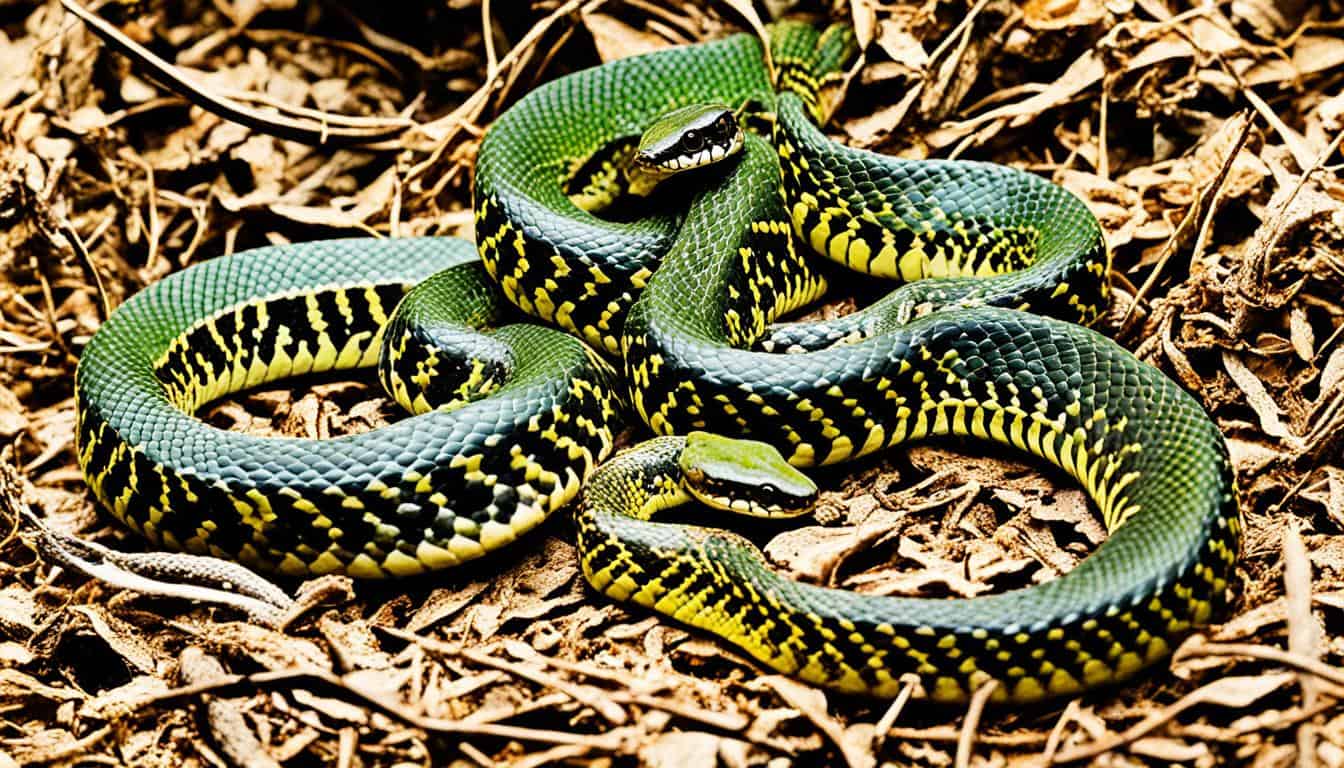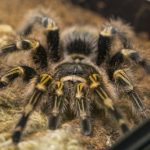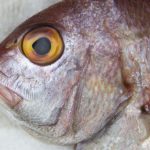Have you ever thought about the number of venomous snakes in the United States? The variety of them might surprise you. The USA is home to snakes like rattlesnakes, copperheads, and even brightly colored coral snakes. Each snake is unique and can be dangerous, so knowing how to identify them is key. This skill is important for anyone who loves being outside.
Understanding Venomous Snakes in the USA
In the United States, venomous snakes are a key part of the ecosystem. They are interesting yet often not well-known creatures. It’s important to learn about these snakes and know why it matters to be able to recognize them.
Definition of Venomous Snakes
“Venomous snakes” are those that produce venom. This venom helps them kill prey and defend themselves. In the U.S., venomous snakes include the rattlesnake, copperhead, cottonmouth, and coral snake. They inject venom through bites, which is called envenomation.
Importance of Identifying Venomous Species
Knowing how to identify these snakes is crucial for people who work outside, nature lovers, and those who live in areas where snakes are common. It allows them to take steps to avoid getting bitten. It also helps in offering the right first aid if someone is bitten, lowering the danger of the bite.
Types of Venomous Snakes in the United States
The United States has several kinds of venomous snakes. They are dangerous for different reasons, depending on their features and where they live. Knowing about these snakes is key for staying safe.
Rattlesnakes
Rattlesnakes are well-known in the USA. They make a sound like a rattle. You can find them in deserts and grasslands. The Western Diamondback and Eastern Diamondback are big, with unique patterns.
Copperheads
Copperheads are dangerous too. They have red heads and an hourglass pattern. They like woods and rocky areas. They hide well to catch their prey.
Cottonmouths (Water Moccasins)
Cottonmouths, or Water Moccasins, live in the southeast. They have white mouths. These dark snakes can be aggressive. They might warn you with their open white mouths.
Coral Snakes
Coral snakes are brightly colored. Their red, yellow, and black bands warn predators of their toxic bite. They live in places like Arizona. Coral snakes hide under leaves or in the ground.
How to Identify Venomous Snakes
Finding venomous snakes in the USA means looking at certain signs. You should check for special physical looks, how they act, and what colors or marks they have. Knowing these signs really helps spot US venomous snakes.
Physical Characteristics
First, focus on what the snake looks like. Venomous ones often have a head that looks like a triangle, eyes like slits, and a bigger middle. Rattlesnakes stand out with a noisy rattle on their tail. Also, copperheads have marks that look like hourglasses on their sides. Cottonmouths show a bright white inside their mouths.
Behavioral Traits
How a snake acts can also tell you if it’s venomous. Many venomous snakes act tough when they feel scared. Rattlesnakes shake their tails to warn. Cottonmouths might show their white mouths. Usually, these snakes mean business when they stand their ground.
Color Patterns and Distinctive Marks
The way these snakes look is key to telling if they’re venomous. Rattlesnakes often have shapes like diamonds on their skin. Copperheads are unique with red heads and dark bands that make it look like they’re wearing hourglasses. Coral snakes have bright colors in the order of red, yellow, and black. This is a big clue for spotting venomous species.
| Snake Species | Physical Characteristics | Behavioral Traits | Distinctive Marks |
|---|---|---|---|
| Rattlesnake | Triangular head, rattle at tail end | Rattling sound | Diamond patterns |
| Copperhead | Hourglass bands, copper-red head | Defensive posture | Hourglass banding |
| Cottonmouth | White mouth interior | Open mouth display | Dark, sturdy body |
| Coral Snake | Red, yellow, black bands | Secretive behavior | Sequential banding pattern |
By looking at what they look like, how they behave, and their colors, you can get good at telling which snakes are venomous in the USA.
Rattlesnakes: The Most Common Venomous Snake in the USA
Rattlesnakes top the charts as the most common venomous snake in the USA. They’re known by the sound of their rattle. This is their way of telling others to stay back. The Western Diamondback and the Pygmy Rattlesnake are two key types.
Western Diamondback
The Western Diamondback Rattlesnake is easily noticed by its diamond shapes. It’s often seen in the US Southwest and parts of Baja California. This snake’s size and markings set it apart from the others.
Pygmy Rattlesnakes
The Pygmy Rattlesnake is smaller but just as noticeable. It has a unique buzz to warn others. Found all over the US, it comes in different colors to match its surroundings.
Subspecies and Variations
Rattlesnakes come in many types, each perfect for their own home. From the wide deserts to dense forests, there’s a rattlesnake for every spot. Learning about these differences shows how rich the rattlesnake variety in the USA is.
Copperheads: Features and Habitat
Copperheads are venomous snakes found in the southeastern U.S. They have a unique look that helps identify them.
Identifying Characteristics
To spot a Copperhead, search for a red-copper head and an hourglass pattern on its body. This pattern is dark, creating an hourglass against a lighter color. Their pupils are narrow and vertical, making them stand out.
Common Habitats
Found mainly in the U.S. Southeast, Copperheads also like rocky areas. Their pattern lets them blend in with leaves and other forest cover. This pattern helps them hide and stay safe.
Cottonmouths: The Water Moccasins
Cottonmouths are known as Water Moccasins. They have unique traits and habits. These snakes live in the southeastern United States. They are interesting and play a big role in their environment.
Characteristics of Cottonmouths
The cottonmouth snake features are dark and strong. This helps them hide in marshes. If they feel threatened, they show the white inside of their mouths. It’s a special warning. Their strong bodies and love for water make them good at living on land and in the water.

Typical Locations
Water Moccasin locations are in the southeastern U.S. They are often found in places like Florida with lots of wetlands. These snakes like swamps, ponds, and wet areas. Their ability to live in water helps them hunt well.
| Region | Common Habitats |
|---|---|
| Florida | Swamps, Ponds, Streams |
| Louisiana | Bayous, Marshes |
| Georgia | Wetlands, Rivers |
Coral Snakes: Vibrant yet Deadly
Coral snakes have red, yellow, and black bands that make them stand out. Knowing their colors is important. It helps to tell them apart from harmless snakes.
Color Patterns
Rhyming “Red touch yellow, kill a fellow; red touch black, venom lack” is a way to remember coral snakes. This color scheme is vital. It lets us know if a snake is the dangerous kind or a look-alike.
Habitat and Behavior
These snakes live in the southeastern US and some parts of Arizona. They hide well in places like leaf piles or underground. Even though they are pretty, coral snakes are shy. They usually come out at night or in the rain to find food.
Learning about where and how coral snakes live is key. It helps us stay safe by knowing how to avoid them. Remembering their habits can prevent dangerous encounters.
The Impact of Venomous Snake Bites in the USA
Each year, the USA sees between 7,000 and 8,000 snake bite cases. Although deaths are not common, it’s important to grasp the full impact of such bites. This includes what medical care helps and what possible long-term effects there can be.
Incidence and Statistics
The USA faces thousands of snake bites every year. Many of these come from snakes like rattlesnakes and copperheads. Getting medical help quickly is key to lowering the damage from these bites.
Medical Treatments and Antivenin
There are special treatments like CroFab® to fight snake venom. These treatments play a big part in lessening the harm from snake bites. Getting to a doctor fast to have these treatments is important. It helps patients recover sooner.
Long-term Effects of Snake Bites
Even with treatments, snake bites can still cause lasting issues. This can mean long-lasting pain, infections, and even lasting harm to parts of the body. Knowing the risks underlines why quick and good medical help is crucial.
Safety Tips to Avoid Venomous Snake Bites
Meeting a venomous snake can be scary, but knowing what to do helps a lot. Here are some important safety tips. They include how to keep safe, what to do if you see a snake, and first aid for bites.
Precautions in Snake-prone Areas
- Stay away from tall grass, brush, and leaf piles where snakes like to hide.
- Always wear long pants and boots when you’re outside.
- Keep to paths and trails. This reduces the chance of stepping on a snake by mistake.
- Be careful around rocks and logs; snakes often hide there.
What to Do if You Encounter a Venomous Snake
Finding a snake can startle you. Follow these steps if you do:
- Stay calm and don’t go near the snake. Most won’t attack unless they feel threatened.
- Slowly back off and let the snake go its own way.
- Don’t try to touch or scare the snake. Just let it be.
First Aid for Snake Bites
If a snake bites you, staying calm and acting quick is critical:
- Stay calm and still to slow down venom movement.
- Keep the bite area lower than your heart.
- Take off tight items from the bitten area.
- Don’t try home remedies, like cutting the bite or sucking out venom.
- Get to a hospital or clinic right away for proper treatment.
| Precaution | Reason |
|---|---|
| Stay on marked trails | Reduces risk of disturbing hidden snakes |
| Wear protective clothing | Provides a barrier against bites |
| Be aware of surroundings | Helps in early detection of snakes |
Are there any venomous snakes in the USA?
Are there venomous snakes in the USA? Yes, several species can be found here. This includes rattlesnakes, copperheads, cottonmouths, and coral snakes. They live in different parts of the country. It’s important to know where these snakes are if you’re out in nature or live near them.
Rattlesnakes are the most common venomous snakes in the USA. You can spot them from deserts to forests. Copperheads live in the southeast and have a distinctive look. Cottonmouths like watery places and are found in the southeast. Coral snakes, with red, yellow, and black bands, are in various areas, including the southeast and Arizona.
Knowing about these snakes is key to staying safe. By keeping a safe distance and being alert, you can avoid dangerous encounters. Being mindful and respecting nature is crucial. In conclusion, these snakes are fascinating but can be harmful, making them a unique part of American wildlife.
FAQ
Are there any venomous snakes in the USA?
Yes, lots of venomous snakes call the USA home. They include rattlesnakes, copperheads, cottonmouths, and coral snakes. Each one is different and can be dangerous to people.
What is the definition of venomous snakes?
Venomous snakes have special glands that make venom. They use this venom to catch food and protect themselves. When they bite, they inject this venom.
Why is it important to identify venomous snake species?
Knowing which snakes are venomous is crucial for staying safe. This is true for those who work outside, love the outdoors, or live where snakes are common. It helps in warning others and getting the right help fast if someone is bitten.
What types of venomous snakes are found in the United States?
In the USA, you’ll find species like rattlesnakes, copperheads, cottonmouths, and coral snakes. These snakes are spread out across the country, living in their specific types of habitats.
How can you identify venomous snakes based on their physical characteristics?
You can tell if a snake is venomous by looking at its body and head. For example, rattlesnakes have rattles on their tails. Copperheads have a distinct copper-red head.
What are some behavioral traits of venomous snakes?
Venomous snakes have ways to warn you they’re dangerous. For instance, rattlesnakes make a hiss or shake their tails. And cottonmouths show their white mouths.
How can you distinguish venomous snakes by their color patterns and distinctive markings?
Venomous snakes have unique color and pattern signs. Rattlesnakes have diamond shapes. Copperheads have hourglass bands. Cottonmouths show their white mouths. Coral snakes have red, yellow, and black bands.
What are the common characteristics of rattlesnakes in the USA?
Rattlesnakes are known for the sound they make with their tails. For example, the Western Diamondback lives in the West. Meanwhile, Pygmy Rattlesnakes are smaller and found all over.
How can you identify copperheads, and where are they commonly found?
Look for a snake with a copper-red head and hourglass shapes on its body. These are copperheads. They live in the Southeast, especially in forests and rocky areas where they blend in well.
What are the characteristics and typical locations of cottonmouths (water moccasins)?
Cottonmouths look dark and tough. They are found mostly in the Southeast, in places like Florida. They like wet areas like swamps and live near water.
How can you identify coral snakes, and what are their habitats?
Coral snakes have bright red, yellow, and black bands. They live in places like the Southeast and Arizona. They hide in leaves or under the ground. Remember, “Red touch yellow, kill a fellow; red touch black, venom lack” to identify them safely.
What is the incidence and impact of venomous snake bites in the USA?
Each year, America sees 7,000 to 8,000 snake bites. Fatal cases are rare, thanks to medical care. But bites can still cause harm. For treatment, antivenin like CroFab® is used.
What are some safety tips to avoid venomous snake bites?
To stay safe from snake bites, watch out in snake areas and learn about their habits. If bitten, get help right away. Keep calm and don’t use homemade treatments. It’s important to know first aid and have medical help nearby.







